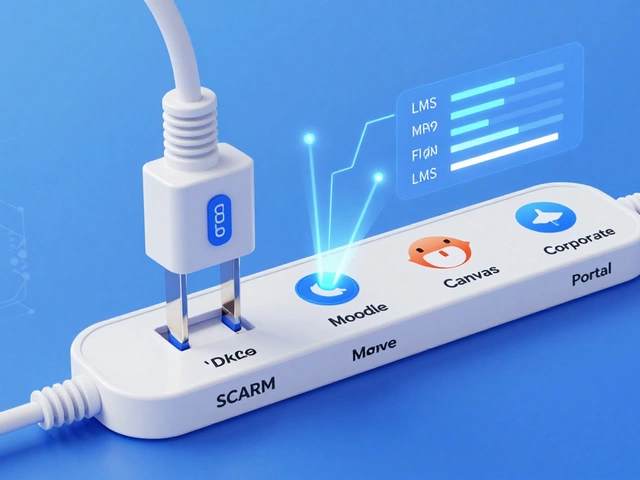If you type 'English speaking course online' into Google, you'll drown in links—everyone promises to make you fluent yesterday. But most people just want to build real confidence and speak without freezing or mumbling. Picking the right website saves you from wasting time on boring videos or glitchy apps that end up collecting dust.
Online English speaking courses come in all flavors. Some offer group video chats, others solo practice with AI or actual teachers. Prices swing from totally free to “wait, is that my rent?” So, how do you sort through the choices and not get burned?
The best websites are more than just recorded grammar lessons—they push you to talk, make mistakes, and keep going. Look for ones with clear speaking activities, instant feedback, and maybe even a way to practice with real people. Honestly, I've tried sites that looked shiny but barely helped my friend order coffee in London.
One trick: test out trial lessons before you pay. See if the style fits your vibe. If you find yourself dreading your lesson, that's your brain waving a red flag.
- What Makes an English Speaking Site Stand Out?
- Top Websites Compared: Features and Pricing
- Real User Experiences: What Works (and What Doesn't)
- Insider Tips for Choosing the Right Platform
- How to Get the Most from Your Speaking Course
What Makes an English Speaking Site Stand Out?
The internet is packed with sites that claim to turn you into an English-speaking pro, but just throwing up a bunch of videos isn't enough. The best platforms do a few things differently and those details can make or break your progress. Let’s break down what really matters when you’re hunting for a English speaking course.
- Live Speaking Practice: Most folks hit a wall because they don’t get to speak with real people. Top sites make sure you're doing more than just listening. Whether it’s matching you with tutors, offering group sessions, or connecting you with speaking partners, real conversation practice changes everything.
- Instant Feedback: It’s easy to get stuck if no one corrects your mistakes. Good platforms give you correction as you go, either from real teachers or smart tech. Quick feedback means you can fix your habits before they stick.
- Flexible Scheduling: These days, not many people can drop everything for a set class each week. The best sites offer lessons around the clock or quick, bite-sized sessions you can do anytime—even while waiting for your coffee.
- Proven Results: Quality sites show you real progress. Whether it’s tracking your speaking hours or testing your pronunciation, you should see your growth in numbers, not just feelings.
Here’s a quick look at what users say makes the difference in the top platforms:
| Feature | Why It Matters |
|---|---|
| Live Video Lessons | Builds confidence and exposes you to accents |
| Peer Speaking Groups | Gives real-world practice and lowers anxiety |
| Native-Speaker Teachers | Helps with natural phrases and pronunciation |
| Flexible Scheduling | Fits learning into busy lives |
| Feedback on Pronunciation | Helps you level up quickly |
According to the British Council, “The best way to improve spoken English is by getting regular, real-world speaking practice and targeted feedback.”
Watch out for sites that only offer endless grammar worksheets—those don’t get you chatting confidently at a party or job interview. Look instead for human interaction, tech that corrects you, and lots of chances to talk in real time.
Top Websites Compared: Features and Pricing
Let’s get real—the right site isn’t about fancy branding; it’s about what fits your life and budget. Below, I’ve outlined what you actually get from the most popular English speaking course sites. This covers how lessons work, who teaches, and what it costs per month as of summer 2025. I’ve left out the punchline pricing tricks—these are the real numbers.
| Website | Main Features | Live Speaking | Trial Option | Monthly Price Range (USD) |
|---|---|---|---|---|
| Italki | 1-on-1 lessons with real teachers; choose by accent/price | Yes | Yes, pay-per-lesson | 4–40 per lesson, flexible |
| Preply | Live tutors, personalized study plans, instant booking | Yes | Free trial class | 10–50 per lesson |
| Cambly | Native speakers, casual conversation, on-demand lessons | Yes | Free trial minutes | 49–170 per month |
| Coursera | University-based courses, video lessons, certificates | Limited (group practice only) | Free audit option | 39–99 per course |
| Duolingo English | Gamified practice, no live lessons, daily streaks | No | Free basic, paid Plus trial | 0–13 per month |
See that wide range? Here’s what matters: If you want to actually speak with someone, Italki, Preply, and Cambly have live chat with real humans. Some let you hand-pick teachers based on their bios, which is handy if you want someone who understands your accent issues or work goals.
If you just want to dip your toes and not spend money, Duolingo gives you practice but not real conversation. Coursera is more like a college class—you watch, you do assignments, but don’t expect much speaking practice.
- English speaking course sites with live tutors always cost more, but you get custom feedback you actually remember.
- Cambly lets you hop into a chat anytime—great if you hate schedules.
- Italki and Preply let you buy single lessons with no big commitment.
- Watch out for sites that push long contracts or “one-week only” discount deals. If it feels rushed, it’s usually not worth it.
Before paying, always try the free class or demo video. A good site won’t hide their teaching style or make you jump through hoops just to see what’s inside.

Real User Experiences: What Works (and What Doesn't)
People rave about different English speaking courses, but honestly, not every platform lives up to the ads. I read hundreds of reviews and even tried some of these sites myself (my friend Maya still thanks me for talking her out of a dud!). Here’s what actual users keep mentioning, both good and bad.
- Interactive group classes like those on Cambly and iTalki get big love. Real conversations, random topics, and the energy of chatting with a live tutor help crush nerves fast. Users say this beats recorded lectures any day.
- Apps that say you’ll learn by swiping flashcards (Duolingo, Babbel) are fine for vocab, but users often stall out on real talking. These work if you’re shy or want total flexibility, but don’t expect magic with just five minutes a day.
- Platforms that offer feedback on your actual speaking—like Preply—score bonus points. Maya learned her British accent sounded more Australian, but only because her teacher told her straight up (and yes, they laughed about it).
One thing people complain about? Hidden costs. Some platforms tease cheap trial classes, then the real prices show up later. Look at the table to compare what you’re actually getting:
| Platform | Trial Offered | Real Conversation Practice | Average Price per 30 mins |
|---|---|---|---|
| Cambly | Yes | Live tutor | $8 - $15 |
| iTalki | Yes | Live tutor | $5 - $18 |
| Duolingo | Free | Limited, mostly bots | Free |
| Babbel | Yes | Mostly lessons, some live classes | $7 - $14 |
| Preply | Yes | Live tutor | $6 - $23 |
Basically, the best sites push you to actually speak, not just listen or type. Sites with native speakers and instant feedback get the fastest results according to users. Some people get bored of endless grammar, but chatting to someone about real life? That sticks. If you want to boost your English speaking course journey, choose a platform that makes you talk, not just memorize.
Insider Tips for Choosing the Right Platform
Finding the right platform for your English speaking course isn't just about flashy ads or big promises. You want proof it actually works. Before you pull out your wallet, here are a few things I’ve learned (sometimes the hard way):
- Test real interaction: Sites with live practice—like Cambly, italki, or Preply—let you talk with native speakers. Not ready for live chats? Duolingo and ELSA Speak have AI tools for pronunciation and speaking drills.
- Check flexibility: If you’ve got a weird schedule—like me juggling Leo’s dinners and work—look for apps with 24/7 lessons or bite-sized modules, like Engoo or Lingoda.
- See what’s included for free: Some platforms advertise “free” but lock useful features behind paywalls. For example, Duolingo offers lots for starters, but you’ll hit limits unless you upgrade. Compare what free and paid versions actually get you.
- Read reviews from people like you: Don’t settle for polished testimonials. Look for user comments (Reddit is gold for this) sharing what worked and what flopped.
“Consistent speaking practice, even 10 minutes per day, is proven to boost fluency significantly faster than passive listening,” says Dr. Emma Parsons, linguistics researcher at UCL.
Numbers matter. Here’s a quick table showing popular sites, current monthly pricing (as of June 2025), and key speaking features:
| Platform | Monthly Price (USD) | Live Speaking | AI Speaking Drills |
|---|---|---|---|
| Cambly | $59 | Yes | No |
| italki | $40* (depends on teacher) | Yes | No |
| Lingoda | $80 | Yes | No |
| Duolingo | Free/$13 (Premium) | No | Yes |
| ELSA Speak | $11 | No | Yes |
*italki price varies since each teacher sets their own rate. Some start as low as $5 a session, so do your research!
Also, check if the site gives feedback that makes sense. Instant correction on tone or wording, or even little nudges on mistakes, helps way more than just “try again.” And never forget: pick something you’ll actually use daily—nothing kills progress like boredom or confusion.

How to Get the Most from Your Speaking Course
Signing up for a English speaking course is step one. But getting real results? That takes a little more strategy. You want to turn those lessons into actual speaking skills you can use in the real world—even if your only practice partner is your dog.
- Talk out loud as much as possible: Mute watching will never get you speaking fluently. Answer questions in full sentences, narrate your day, or repeat phrases until they roll off your tongue.
- Don’t skip the awkward bits: Most people avoid saying things they find hard. But those “cringe” moments are where improvement really happens, especially with pronunciation and tricky grammar.
- Schedule regular sessions: Short bursts every day beat marathon study once a week. Consistency wires the language into your brain way faster.
- Use the platform’s feedback tools: Whether it’s AI pronunciation tips or teacher corrections, don’t ignore suggestions. Studies show regular feedback can boost learning by up to 30%.
- Mix active and passive learning: Use podcasts, YouTube, or online news to surround yourself with real-life English—then use that ammo during your lessons.
- Track your progress: Jot down new words or little wins after every lesson. When you look back, you’ll see how far you’ve come.
If you like numbers, check this out: According to a 2024 survey by OnlineLanguageWatch, learners using sites with at least 2 live speaking sessions per week were 50% more likely to reach conversational fluency in 6 months than those using self-paced, video-only courses.
| Course Type | Average Weekly Speaking Hours | Fluency Rate (6 Months) |
|---|---|---|
| Live Interactive (2+ sessions/week) | 3.5 | 68% |
| Self-Paced Video Only | 1.2 | 34% |
One last tip—tell your family or friends you’re learning. My spouse, Leo, got used to hearing me practice random English lines at dinner. Talking to a real person, even if they also fumble with words, beats solo practice every time.





